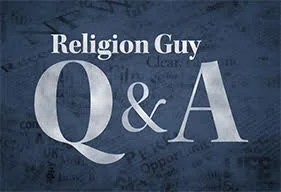RACHAEL ASKS:
Is there a Bible that’s the most accurate?
THE RELIGION GUY’S ANSWER:
Almost all the varied 20th and 21st Century English translations on sale are sufficiently accurate and can be relied upon, though debates will never end on some details.
The first and fundamental aspect of accuracy is experts’ shared consensus on the best available texts in the original languages of Hebrew and Greek that underlie all translations, based upon a far richer body of surviving manuscripts than we have for other ancient writings. Here’s a somewhat over-simplified rundown.
Hebrew versions of the Jewish Bible or Tanakh, which Christians call the Old Testament, employ Judaism’s authoritative Masoretic Text. The ancient Hebrew language did not use written vowels, so medieval scholars known as Masoretes added “vowel points,” markings that standardized oral traditions on the correct readings of the words. This led to the 9th Century Aleppo Codex, corroborated by the 11th Century Leningrad Codex and other rabbinical manuscripts.
These carefully preserved texts are virtually identical in wording, though with some variations in pointing, and provide the basis for Jewish and Christian Bibles. The 15th Century emergence of printed Bibles further standardized the Hebrew text. The 20th Century rediscovery of biblical books among the 2,000-year-old ”Dead Sea Scrolls” added certain variations that translators consider.
With the New Testament, thousands of Greek manuscripts and fragments from Christianity’s early centuries exist. Today’s translators work from a standard “eclectic” Greek version formulated from these by specialists in “textual criticism” who decide which variants are closest to the original writings. Technical note: “earliest” does not necessarily mean “best” manuscript.
The resulting shared resource for translations is the German Bible Society’s continually updated text with all important variations, most recently the 2017 “Nestle-Aland Greek New Testament, 28th Edition, with Critical Apparatus.” Major translations undergo periodic tweaking based on this ongoing work. A prominent evangelical, the late Bruce Metzger of Princeton Theological Seminary, was the American leader in this international project.
Modern English Bibles provide candid footnotes that alert readers to important textual variants, which rarely affect basic biblical doctrines.
One example, which may surprise some readers, is Jesus’ cherished words at the Crucifixion, “Father, forgive them for they know not what they do” (Luke 23:34). Evangelicals’ popular New International Version (NIV, 1978, updated 2011), admits in a footnote that “some early manuscripts do not have this sentence.” U.S. Catholicism’s official New American Bible (NAB, 1970, revised 2011, with Old Testament books Jewish and Protestant Bibles omit) explains in more detail that this sentence “does not occur in the oldest papyrus manuscript of Luke and in other early Greek manuscripts and ancient versions of wide geographical distribution.”
There’s similar textual ambiguity with the equally beloved passage about Jesus forgiving the adulterous woman in John 7:53 – 8:11.
Aspect number two is debates over the accuracy of the English translations drawn from those reliable agreed texts. It’s impossible for The Religion Guy to even summarize here all the renditions on the market, but readers can compare for themselves searchable full texts of 54 options at Bible Gateway. Also you’ll find basic info about many English editions at GotQuestions.org, on the Bible versions page.
One major choice is British Protestantism’s “Authorized” or King James Version from four centuries ago, long the literary standard across the English-speaking world. There’s similar wording in Catholics’ Douay-Rheims version from that same era and in the Jewish Publication Society’s The Holy Scriptures (1917, not to be confused with the modernized JPS Tanakh of 1985, revised 1992). Some right-wing Protestants insist on “King James Only.” There’s also the slightly modernized New King James Version (NKJV, 1982).
The King James words can be hard going for 21st Century readers. Also, its translators lacked access to key ancient manuscripts available today, meaning modern Bibles get closer to what was written originally. But the culture has certainly lost something with the demise of largely-shared scriptural phraseology.
King James wording is substantially carried on in e.g. the ecumenical Revised Standard Version (1952, 2nd edition 1971), evangelicals’ English Standard Version (2001, updated 2016) and somewhat less so in the New Revised Standard Version (NRSV, 1989, updated 2021), which employs gender-inclusive wording wherever possible. Keep an eye on a more dramatic effort in Israel to create a future “non-binary” form of the Hebrew language to reshape the Old Testament.
A basic distinction among translations is between “formal equivalence” a la the King James, leaning toward literal word-for-word translation, and “functional equivalence” aimed at thought-for-thought understanding to aid contemporary readers.
CONTINUE READING: “Is there a Bible that's the most accurate?” by Richard Ostling.


